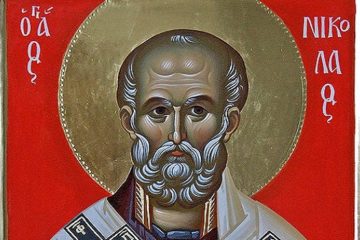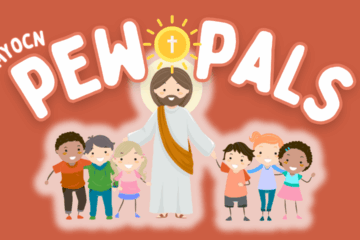Hierodeacon Rafael Misiaoulis, Theologian
On the first Sunday in Lent we celebrate the restoration of the holy icons. The Church celebrates. Orthodoxy celebrates. The human race celebrates, since all of us are made in the image (icon) of God. The Church confesses in a variety of ways. It gives a confession of faith through words, deeds and symbols. With the body, soul and spirit. And also through the holy icons. On this day we honor all those God-bearing Fathers who, with their blood, their knowledge, their wisdom and their writings, confessed Orthodoxy and the theology of the icons. The teaching of the Church concerning icons is one of the most important chapters in Patristic theology. An icon is an expression of the Tradition of the Church, equal to written and oral tradition. The icons which adorn a church aren’t simply decorative features, they’re not just religious paintings, they’re tokens of the encounter between heaven and earth; in a visible manner, they express the sense of heaven on earth.
If we look at the Old Testament, we’ll see that the first indication of the concept of the icon in Christianity occurs in the book of Genesis [1]. Saint Gregory the Theologian links the creation of the world with the existence of icons [2]. Another point in the Old Testament which is evidence for the main argument in favor of icons is associated with the command given by God that the cherubim be depicted in the Tabernacle of Witness [3]. According to the spirit of the Old Testament, the kingdom of God is the presence of God and the revelation of his plan. This is of a historical nature, since it is accomplished in time and space, through his people Israel and after his first appearance to Abraham.
In the New Testament, the importance of the image is emphasized by the relationship between the Father and the Son, in the Gospel according to Saint John: ‘those who have seen me have seen the father’ [4]. This denotes the internal relationship between the Father and the Son, but also confirms the incarnation of the divine Word. A good many images and symbols are also presented in the New Testament through Christ’s parables and there is also testimony in the writings of the Fathers of the Church. The relationship between Christology and the theology of the icon is demonstrated in the New Testament, where Christ is called ‘the image of God’, especially as regards the incarnation of the Son and Word of God.
In the Patristic tradition, the term ‘image’ or ‘icon’ is used in Trinitology in order to emphasize both the natural identity as well as the hypostatic distinction between the archetype, the Father, and the Son and Holy Spirit. The latter are able to be depicted in images.
The depiction of the incarnate Word of God refers to his humanity, not his divinity. ‘The Word became poor, hungry and thirsty in the flesh: these are attributes of human nature through which he can be described. As regards divinity he (the divine Word) is simple and cannot be described’ [7]. ‘Who can make a copy of God, who is invisible, bodiless, indescribable and formless? It is the height of delusion and impiety, then, to depict the divine’ [8].
A good number of the Church Fathers refer to the existence of icons, including Saint Gregory the Theologian in his 4th Denunciative Discourse against the Emperor Julian [9]; and Saint Gregory of Nyssa in his discourse on the divinity of the Son [10]. It ought to be stressed here that the main subject in these texts is the image, which focuses on the existence of the human person and the manner in which it’s depicted in the Holy Trinity [11].
In the book on the Holy Spirit, by Saint Basil the Great, there is the first mention of the phrase ‘the honor paid to the image passes on to the original’, which is a basic source in theology and to which Church tradition has applied the term ‘icon’. Basil says that the tradition of the Church concerning the Holy icons is ‘apostolic’. There were icons in churches before the time of Constantine the Great, a practice dating from Apostolic times. This tradition has been confirmed by architectural finds, from the earliest post-Apostolic years, which depict the person of Christ. Images were a factor in ecclesiastical life, as is apparent from ancient churches and the works of the Fathers. In 692, the Quinisext Synod supported this tradition with canon 82 which forbade any depiction of Christ as a lamb on the cross and insisted on his being portrayed in human form [12].
Notes
[1] Gen. 1, 26, 27 ‘Then God said, “Let us make man in our image, after our likeness’… ‘So God created man in his own image, in the image of God he created him’.
[2] On the image and likeness of God, PG, 44, 1328AC.
[3] Exodus 25, 18-22 and 26,1.
[4] John 14, 9].
[5] 2 Cor. 4, 4.
[6] Cyril of Alexandria, On John, 2, 8 PG 73, 360CD.
[7] Theodore the Studite, Tropario, ode 7, canon for Orthodoxy.
[8] John the Damascan, On icons, chapter 16, PG 94, 1169 C.
[9] ΕΠΕ, vol.5, pp. 138-139.
[10] ΕΠΕ vol. 10, pp. 58-61.
[11] On the formation of humankind, PG 3154, PG 44 124D-256.
[12] ‘In some pictures of the venerable icons, a lamb is engraved, to which the Forerunner is pointing his finger, which is has been understood as a type of grace, adumbrating our true Lamb, Christ our God, through the Law. Embracing therefore the ancient types and shadows as symbols of the truth, and patterns given to the Church, we prefer grace and truth as the fulfilment of the Law. In order, therefore, that that which is perfect may be delineated to the eyes of all, at least in colored expression, we decree that the figure of the Lamb who takes away the sin of the world, Christ our God, be henceforth exhibited in icons in human form, instead of the ancient lamb, so that all may understand by means of it the height of the humility of the Word of God, and that we may bear in mind his actions in the flesh, his suffering and salutary death, and his redemption which was wrought for the whole world’.
Source: pemptousia.com




0 Comments